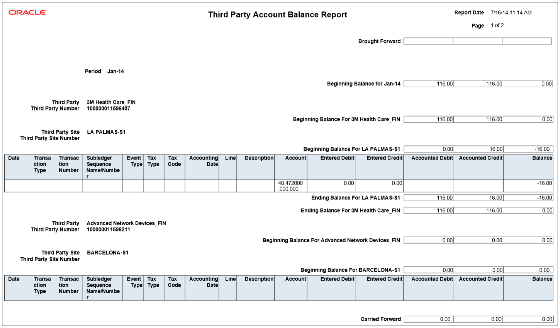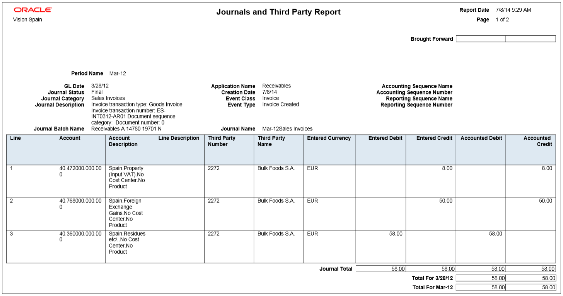Third-Party Detail and Balances Reports
This topic includes details about third-party detail and balances reports.
Overview
The third-party detail and balances reports include:
-
Third-Party Balances Summary Report: Displays information for each account of the third party and third-party site, and account identification. This report is a tool for auditing third-party accounts.
The following figure is an example of the report.

-
Third-Party Detail and Balances Report: Provides third-party account balances and accounting activity details for a period. You can review the accounting process details by third party and audit third-party accounts in detail.
The following figure is an example of the report.

-
Third-Party Account Balance Report: Prints account and original third-party transactions impacting the account during a particular period. The report is run to ensure that subledger and general ledger balances reconcile, and to identify possible reasons for any discrepancies.
The following figure is an example of the report.

-
Journals and Third-Party Report: Prints all the journals posted to the general ledger for an accounting period. It provides detailed subledger accounting entry lines regardless of the general ledger journals summarization. Transaction line description, third-party name and number, and transaction amounts in entered and ledger currency. The report uses legal sequencing rules for both accounting entries and source documents to verify if all journals are recorded in a chronological order without gaps. The report lets you create various views of reported information based on seven flexible sorting rules that help with reconciliation and auditing.
The following figure is an example of the report.

Key Insights
Before submitting the reports, complete the following tasks:
-
Ensure that the third-party control account balances are available for printing for the selected date and account range.
-
Manually run the Update Subledger Account Balances process for your ledger and application, if you accounted your third-party transactions online.
During the accounting process, run the reports to ensure that subledger and general ledger balances reconcile, and to identify discrepancies such as:
-
Transaction amounts are assigned to incorrect accounts. For example, an invoice distribution amount is assigned to a liability account.
-
Transactions aren't posted to the general ledger.
-
Journal batches aren't posted in the general ledger.
For each account, the report displays beginning balance, period activity, and period end balance.
Report Parameters
The following table lists selected parameters for the Third-Party Balances Summary Report:
|
Parameter |
Description |
|---|---|
|
Report Heading |
Print report headings, select one of the following options: Ledger, Legal Entity, and Statutory Header for Italy. |
|
Journal Entry Source |
Enter the source of journal entries, such as payables, receivables, or manual. |
|
Third-Party Type |
Indicate the party type, such as supplier or customer. |
|
Third-Party Name |
Submit the report for a specific third party, or leave this field blank for all third parties. |
The following table lists selected parameters for the Third-Party Detail and Balances Report:
|
Parameter |
Description |
|---|---|
|
Journal Entry Source |
Enter the source of journal entries, such as payables, receivables, or manual. |
|
Third-Party Type |
Indicate the party type, such as supplier or customer. |
|
Third-Party Name |
Submit the report for a specific third party, or leave this field blank for all third parties. |
The following table lists selected parameters for the Third-Party Account Balance Report:
|
Parameter |
Description |
|---|---|
|
Report Heading |
Print report headings, select one of the following options: Ledger, Legal Entity, and Statutory Header for Italy. |
|
Journal Entry Source |
Enter the source of journal entries, such as payables, receivables, or manual. |
|
Third-Party Type |
Indicate the party type, such as supplier or customer. |
The following table lists selected parameters for the Journals and Third-Party Report:
|
Parameter |
Description |
|---|---|
|
Journal Entry Source |
Enter the source of journal entries, such as payables, receivables, or manual. |
|
Event Class |
Indicate the event class, such as credit memos and debit memos. |
|
Group by Period |
Indicate whether to group the journal entries by period. |
Frequently Asked Questions
The following table lists frequently asked questions about third-party detail and balances reports.
|
FAQ |
Answer |
|---|---|
|
How do I find this report? |
Schedule and run this report from the Scheduled Processes work area on the Navigator menu. |
|
Who uses this report? |
|
|
When do I use this report? |
Use the third-party detail and balances reports to:
|
|
What type of reports are these? |
Oracle Analytics Publisher |